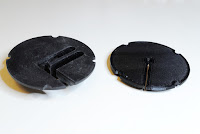Please click on the images for larger view if you would like to see more details.
As many of you know, I bought a Scheppach SD1600v scroll saw.
Of course, for this price one should not expect miracles. The machine seems to work well, but it would be surprising if I could not find some weak points.
The LED light
It is a very useful feature to have a LED light on a long arm, but...
I don't like is that the LED light is pretty weak and it is not possible to turn it on without starting the motor also. This is definitely something I will fix at a later stage.
The dust blower
Again, a very good idea and a useful feature, but the pump pumping the air is not very efficient at low speeds, and the flexible pipe is not intended for this purpose and it takes too much space as well as it gets in the way all the time. I will replace the whole thing with a simple fan later on which will blow more efficiently at a constant power independent of the sawing speed. In the meantime I replaced the tube with a soft silicon tube which is much better than the one delivered with the machine.
A fence
There is no fence delivered, so sawing in straight line is practically impossible. Maybe it is not the proper machine for straight sawing, but I intend to use it for that as well, so in my opinion a fence is necessary. Again, this is going to be done later, but for now I use some temporary solution.
The throat plate
The delivered one may works for general wood work or large pieces, but when small items are sawed the plate is not really a good design, mainly because of the huge gaps in it. I don't know how the designers were thinking at all. Even if the table is tilting, the huge gaps are not necessary.
Regardless which way I rotate the plate the gaps are there and they are making the actual sawing more difficult, even for larger items. I regarded this as the higher priority of all the possible improvements and decided to fix it immediately. As many of you know, I built a CNC which could easily be used for making a new plate out of any material, wood, aluminium or plastic, but because I fairly recently bought a 3D printer kit I decided that this is a perfect exercise in 3D printing so I designed an printed a new plate.
The actual design is fairly simple and straight forward using FreeCAD software. All that was needed was to use a caliper and measure the original one for the dimensions and measure the position of the saw blade when inserted in the saw arms.
On the left is the original, on the right is the 3D printed one. The hole for the saw blade is 6mm in diameter and the gap to slide the throat plate into place is 1.5mm wide. Quite a huge difference compared with the original.
Printing time was about two hours on my printer with my settings, but the results are good, the plate fits perfectly. OK, this is actually the third version, the whole was misplaced a little bit in the first version and after printing the second one and testing, I realized that a small gap was indeed very good to have, so I added the 1.5mm wide gap to be able to change blade without the need of having the plate inserted at the same time.
Now the plate is as good as it gets, the saw blade is perfectly centred and is easy to change blade if necessary. Of course, I can not tilt the table with this plate, if I want to do that I need to change to the original plate for now.
I need to design and make a new one if I want one for tilted table operation with very small gap, but the advantage of a 3D printer is the very short lead time between design and product, and especially for single item, or prototype manufacturing it is very nice to have the possibility of quickly printing readily usable items. Of course, using the CNC would be even faster since it would only take a few minutes to mill out such a plate on my DIY CNC, so perhaps for the next one I will use the CNC, but for now, the 3D printer is the latest toy and is great fun to use it.
Download the STL file
If you want to print one for your own scroll saw then you can download the STL file through this link:
Scroll saw throat plate STL file.
The plate may even other scroll saw machines, there seems to be plenty with similar circular plate.
A quick Google search shows hundreds with similar plates.
The plate whole diameter is 80 mm and with the normal PLA shrinkage the printed item is just perfect. The plate is 3mm thick. Measure your machine before printing because it is pointless to print if you can't use it.






Nice post. Thank you for the post.
ReplyDeleteThank you for your comment.
Delete